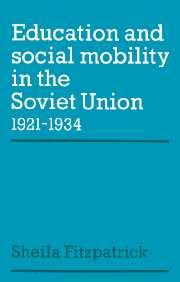9 - The making of a proletarian intelligentsia
Published online by Cambridge University Press: 11 November 2009
Summary
During the First Five-Year Plan, the Soviet leadership undertook a massive programme for the promotion (vydvizhenie) of workers and Communists to higher education. This programme was justified by the threat from ‘bourgeois wreckers’, the need for the proletarian dictatorship to create its own intelligentsia, and the imperatives of the industrialization drive. Bolsheviks must ‘master technology’ in order to rule, Stalin said; and, if they doubted their ability to learn chemical formulae, they should remember that ‘there are no fortresses Bolsheviks cannot storm’.
This was not the first effort to introduce former workers into the intelligentsia through higher education. But it was the first time such a campaign had been a top priority task for the Communist Party; the first time tens of thousands of factory workers and Communists already holding responsible administrative positions had been ‘mobilized’ for full-time study; and the first time that the regime's chosen students had been sent en masse to study engineering.
The new policy produced an upheaval in all higher education, including even the military VUZy, but its greatest impact was on the engineering schools. The VTUZy now had a double responsibility. On the one hand, they were training the ‘Red specialists’ needed to replace the old, untrustworthy, ‘bourgeois’ engineers. But, on the other hand, the VTUZy – together with the new Industrial Academies – were also training the workers and Communists who were to become the industrial managers, administrators and political leaders of the future.
- Type
- Chapter
- Information
- Education and Social Mobility in the Soviet Union 1921–1934 , pp. 181 - 206Publisher: Cambridge University PressPrint publication year: 1979
- 1
- Cited by



